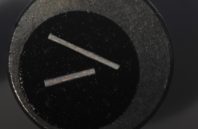MIT engineers have united the principles of self-assembly and 3-D printing using a new technique, which they highlight today in the journal Advanced Materials.
By their direct-write colloidal assembly process, the researchers can build centimeter-high crystals, each made from billions of individual colloids, defined as particles that are between 1 nanometer and 1 micrometer across.
“If you blew up each particle to the size of a soccer ball, it would be like stacking a whole lot of soccer balls to make something as tall as a skyscraper,” says study co-author Alvin Tan, a graduate student in MIT’s Department of Materials Science and Engineering. “That’s what we’re doing at the nanoscale.”
The researchers found a way to print colloids such as polymer nanoparticles in highly ordered arrangements, similar to the atomic structures in crystals. They printed various structures, such as tiny towers and helices, that interact with light in specific ways depending on the size of the individual particles within each structure.

 (585) 768-2513
(585) 768-2513

